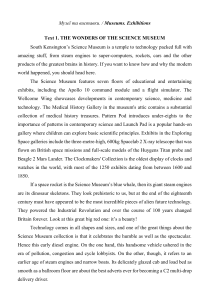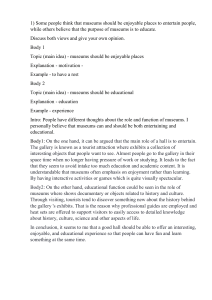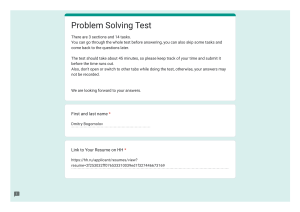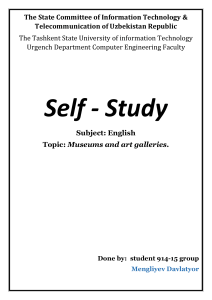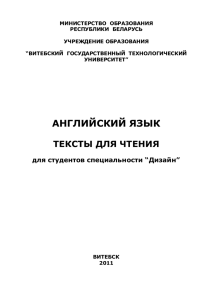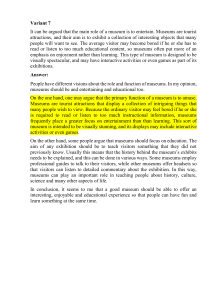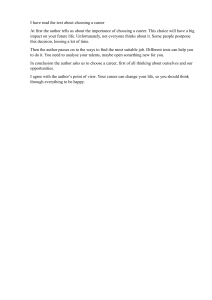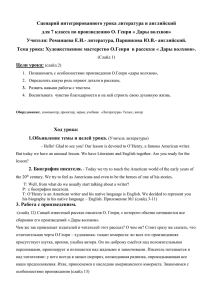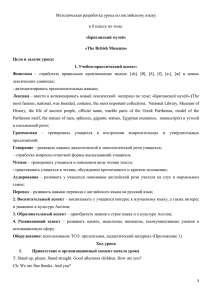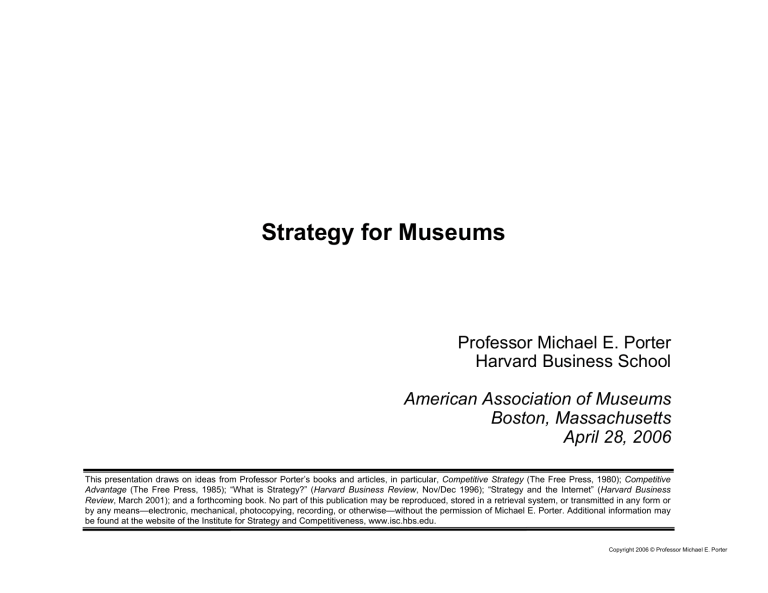
Strategy for Museums Professor Michael E. Porter Harvard Business School American Association of Museums Boston, Massachusetts April 28, 2006 This presentation draws on ideas from Professor Porter’s books and articles, in particular, Competitive Strategy (The Free Press, 1980); Competitive Advantage (The Free Press, 1985); “What is Strategy?” (Harvard Business Review, Nov/Dec 1996); “Strategy and the Internet” (Harvard Business Review, March 2001); and a forthcoming book. No part of this publication may be reproduced, stored in a retrieval system, or transmitted in any form or by any means—electronic, mechanical, photocopying, recording, or otherwise—without the permission of Michael E. Porter. Additional information may be found at the website of the Institute for Strategy and Competitiveness, www.isc.hbs.edu. Copyright 2006 © Professor Michael E. Porter How Museums Think About Competition Threat of Substitute Products or Services Bargaining Power of Suppliers Rivalry Among Existing Competitors Bargaining Power of Buyers Threat of New Entrants • The worst error in strategy is to compete with rivals on the same dimensions American Association of Museums 04/28/06 2 Copyright 2006 © Professor Michael E. Porter Flawed Concepts of Strategy • Strategy as aspiration – “Our strategy is to have one million visitors…” – “…double our endowment…” – “…grow revenue…” • Strategy as action – “Our strategy is to expand the collection…” – “… build a new building…” – “… mount ten special exhibitions per year…” • Strategy as vision / mission – “Our strategy is to serve our community…” – “…to advance science…” American Association of Museums 04/28/06 3 Copyright 2006 © Professor Michael E. Porter Setting the Right Goals Corporations • The fundamental goal of a company is superior long-term return on investment • Growth is good only if superiority in ROIC is achieved and sustained • Profitability must be measured realistically, capturing the actual profits on the full investment for each business American Association of Museums 04/28/06 4 Copyright 2006 © Professor Michael E. Porter The Purpose of Museums • The fundamental purpose of a museum or any other organization is value creation Social Benefits Value = Resources Expended • For museums, there are invariably multiple social benefits, which lead to multiple goals American Association of Museums 04/28/06 5 Copyright 2006 © Professor Michael E. Porter Strategy Foundations Defining the Value Chain Firm Infrastructure (e.g. Financing, Planning, Investor Relations) Human Resource Management Support Activities (e.g. Recruiting, Training, Compensation System) Technology Development (e.g. Product Design, Testing, Process Design, Material Research, Market Research) M (e.g. Components, Machinery, Advertising, Services) Inbound Logistics Operations (e.g. Incoming Material Storage, Data Collection, Service, Customer Access) (e.g. Assembly, Component Fabrication, Branch Operations) Value a Procurement r g Outbound Logistics Marketing & Sales After-Sales Service (e.g. Order Processing, Warehousing, Report Preparation) (e.g. Sales Force, Promotion, Advertising, Proposal Writing, Web site) (e.g. Installation, Customer Support, Complaint Resolution, Repair) i n What buyers are willing to pay Primary Activities • Competing in a business involves performing a set of discrete activities, in which competitive advantage resides • The value chain is unique to each business American Association of Museums 04/28/06 6 Copyright 2006 © Professor Michael E. Porter Strategy Foundations The Museum Value Chain Firm Infrastructure (e.g. governance, planning, budgeting, information tech., facilities) Fundraising (e.g. earned revenues, proposals, solicitations, events, donor relations) Human Resource Management (e.g. recruiting, training, compensation system) Program and Content Development S u (e.g. scholarship, exhibit design, market research) Educational Programs r (e.g. local school outreach, adult classes, special tours) Assembly and Preservation (e.g., acquisition, authentication, cataloguing) American Association of Museums 04/28/06 Exhibition (e.g., curating, display, support materials) Hospitality Services Marketing & Sales (e.g., shops, restaurants, maintenance) (e.g., promotion, advertising, catalogs) 7 p Visitor / Constituency Services l Social Benefits u s (e.g., member outreach, special events) Copyright 2006 © Professor Michael E. Porter Strategy Foundations What are the Different “Businesses” in which the Organization Competes? Program A Program B Program E Program D American Association of Museums 04/28/06 Program C 8 Copyright 2006 © Professor Michael E. Porter Strategy Foundations Operational Effectiveness Versus Strategy Operational Effectiveness Strategic Positioning • Assimilating, attaining, and extending best practices • Run the same race faster American Association of Museums 04/28/06 Creating a unique and sustainable competitive position Choose to run a different race 9 Copyright 2006 © Professor Michael E. Porter Defining Value for Museums • Defining value depends on choosing, specifying, and weighting goals Collection Collection Visitation Visitation Visitor Visitor Experience Experience Education Education Research Research // Scholarship Scholarship • Measuring value is central to any strategy American Association of Museums 04/28/06 10 Copyright 2006 © Professor Michael E. Porter Mission Statements Selected Museums Guggenheim Museum, New York The mission of the Solomon R. Guggenheim Foundation is to promote understanding and appreciation of art, architecture, and other manifestations of modern and contemporary visual culture; to collect, preserve, and research art objects; and to make them accessible to scholars and an increasingly diverse audience through its network of museums, programs, educational initiatives, and publications. Metropolitan Museum of Art, New York The mission of The Metropolitan Museum of Art is to collect, preserve, study, exhibit, and stimulate appreciation for and advance knowledge of works of art that collectively represent the broadest spectrum of human achievement at the highest level of quality, all in the service of the public and in accordance with the highest professional standards. American Museum of Natural History, New York To discover, interpret, and disseminate - through scientific research and education - knowledge about human cultures, the natural world, and the universe. Smithsonian Institution, Washington, DC The Smithsonian is committed to enlarging our shared understanding of the mosaic that is our national identity by providing authoritative experiences that connect us to our history and our heritage as Americans and to promoting innovation, research and discovery in science. MoMA (Museum of Modern Art), New York The Museum of Modern Art is dedicated to being the foremost museum of modern art in the world…The Museum of Modern Art seeks to create a dialogue between the established and the experimental…in an environment that is responsive to the issues of modern and contemporary art, while being accessible to a public that ranges from scholars to young children. The ultimate purpose of the Museum was to acquire the best modern works of art. While quality remains the primary criterion, the Museum acknowledges and pursues a broader educational purpose: to build a collection which is more than an assemblage of masterworks, which provides a uniquely comprehensive survey of the unfolding modern movement in all visual media. 11 American Association of Museums 04/28/06 Copyright 2006 © Professor Michael E. Porter Defining Value for Museums Specifying Goals E.g., • Comprehensiveness • Rarity • Sophistication • Popular appeal • Restoration Collection Collection Visitation Visitation Visitor Visitor Experience Experience Education Education E.g., • Whom to educate – Children – Enthusiasts – Educators – As many people as possible • Means of education – Didactic – Experimental American Association of Museums 04/28/06 E.g., • Number of visits • Repeat visits • Types of visitors (sophistication, age, etc.) • Time spent per visit • Spending per visit Research Research // Scholarship Scholarship E.g., • Level of interactivity • Amount and sophistication of information provided • Extent of ancillary services E.g., • Original vs. applied • Scholarly vs. popular • Conferences vs. publications 12 Copyright 2006 © Professor Michael E. Porter Five Tests of a Good Strategy •• A A unique unique value value proposition proposition compared compared to to other other organizations organizations •• A A different, different, tailored tailored value value chain chain •• Clear Clear tradeoffs, tradeoffs, and and choosing choosing what what not not to to do do •• Activities Activities that that fit fit together together and and reinforce reinforce each each other other •• Continuity Continuity of of strategy strategy with with continual continual improvement improvement in in realizing realizing the the strategy strategy American Association of Museums 04/28/06 13 Copyright 2006 © Professor Michael E. Porter Defining a Strategic Position Whole Foods Markets Distinctive Distinctive Activities Activities Value Value Proposition Proposition • • Natural, fresh, organic, and prepared foods and health items with excellent service at premium prices • • • Educated, middle class, and affluent customers passionate about food as a part of a healthy lifestyle • • • • • • • American Association of Museums 04/28/06 14 Well-lit, inviting supermarket store formats with appealing displays and extensive prepared foods sections Produce section as “theater” Café-style seating areas with wireless internet for meetings and meals Each store carries local produce and has the authority to contract with the local farmers Information and education provided to shoppers along with products High touch in-store customer service via knowledgeable, non-unionized, highly motivated personnel Egalitarian compensation structure Own seafood procurement and processing facilities to control quality (and price) from the boat to the counter Donates 5% of profits to non-profits Each store has “green projects,” directed by employees to improve environmental performance Copyright 2006 © Professor Michael E. Porter Translating Goals into a Value Proposition What What Customers? Customers? Which Which Needs? Needs? E.g., E.g., • • • • • • • American Association of Museums 04/28/06 Adults vs. children Enthusiasts vs. less knowledgeable patrons Tourists vs. locals Current vs. future generations Appreciation Experience Participation What What Price? Price? E.g., • Free • Membership • Fee per admission 15 Copyright 2006 © Professor Michael E. Porter Five Tests of a Good Strategy •• A A unique unique value value proposition proposition compared compared to to other other organizations organizations •• A A different, different, tailored tailored value value chain chain •• Clear Clear tradeoffs, tradeoffs, and and choosing choosing what what not not to to do do •• Activities Activities that that fit fit together together and and reinforce reinforce each each other other •• Continuity Continuity of of strategy strategy with with continual continual improvement improvement in in realizing realizing the the strategy strategy American Association of Museums 04/28/06 16 Copyright 2006 © Professor Michael E. Porter Making Strategic Tradeoffs US Home Improvement Industry Home Home Depot Depot Lowe ’s Lowe’s Value Proposition Value Proposition • Predominately male, experienced customers and contractors • Female shoppers and casual do-it-yourselfers • Building material, home improvement, and lawn & garden products • Extensive home decor, appliance, kitchen, and lawn & garden offerings Set of Activities Set of Activities • No-frills, warehouse design • Appealing store layout - Wider aisles, brighter lighting, lower ceilings - “Stores-in-the-store” featuring fully-equipped kitchen & bath studios, lighting displays, etc. - Merchandise stored in large racks and stacked on the floor • All customers (including contractors) serviced out of same stores • Contractors serviced by separate corporate division with different yards • Bulk deliveries of products directly from vendors usually during the day • Hub-and-spoke distribution with just-in-time delivery usually after hours • Every-day low prices with volume discounts • Every-day low prices without volume discounts • Home Depot is at risk of undermining its strategy through imitation American Association of Museums 04/28/06 17 Copyright 2006 © Professor Michael E. Porter Five Tests of a Good Strategy •• A A unique unique value value proposition proposition compared compared to to other other organizations organizations •• A A different, different, tailored tailored value value chain chain •• Clear Clear tradeoffs, tradeoffs, and and choosing choosing what what not not to to do do •• Activities Activities that that fit fit together together and and reinforce reinforce each each other other •• Continuity Continuity of of strategy strategy with with continual continual improvement improvement in in realizing realizing the the strategy strategy American Association of Museums 04/28/06 18 Copyright 2006 © Professor Michael E. Porter Mutually Reinforcing Activities Zara Word-ofmouth marketing and repeat buying Cuttingedge fashion at moderate price and quality Widely popular styles Very frequent product changes Little media advertising Global team of trendspotters Production in Europe Extensive use of store sales data Prime store locations in high traffic areas JIT delivery Tight coordination with 20 wholly-owned factories Customers chic but costconscious Advanced production machinery Very flexible production system • Fit is leveraging what is different to be more different Source: Draws on research by Jorge Lopez Ramon (IESE) at the Institute for Strategy and Competitiveness, HBS 19 American Association of Museums 04/28/06 Copyright 2006 © Professor Michael E. Porter Continuity of Strategy • Allows the board and the staff to understand and embrace the strategy • Builds truly unique skills and assets related to the strategy • Establishes a clear identity with patrons, funders, and other outside entities • Strengthens alignment of activities across the value chain • Successful organizations continuously improve in realizing their strategy In contrast, • Reinvention and frequent shifts in direction are costly and confuse everyone American Association of Museums 04/28/06 20 Copyright 2006 © Professor Michael E. Porter Barriers to Defining Goals and Setting Strategy for Museums • Unpredictable or limited revenue streams lead to program proliferation or shortterm focus • Multiple, conflicting, or unclear goals • Lack of board consensus on goals • Legacy collections and facilities constrain future direction • Donor / funder desires and priorities • Tactical problems consume managerial attention • No clear way to measure performance • Limited cost information at the activity and program level obscures value • Severe risk of agenda / program proliferation American Association of Museums 04/28/06 21 Copyright 2006 © Professor Michael E. Porter Strategy Should Drive Other Choices Goal Goal Definition Definition Strategy Strategy Definition Definition Outsourcing Outsourcing American Association of Museums 04/28/06 Funding Funding Structure Structure Partnerships Partnerships 22 Geographic Geographic Coverage Coverage Copyright 2006 © Professor Michael E. Porter The Role of Leaders in Strategy • Lead the process of choosing the organization’s unique position – The choice of strategy cannot be entirely democratic • Clearly distinguish strategy from operational effectiveness • Communicate the strategy relentlessly to all constituencies • Maintain discipline around the strategy, in the face of many distractions. • Decide which “competitor” changes, technologies, and customer trends to respond to, and how the response can be tailored to the organization’s unique position • Measure value and progress against the strategy • Commitment to strategy is tested every day, especially in non-profit organizations American Association of Museums 04/28/06 23 Copyright 2006 © Professor Michael E. Porter

